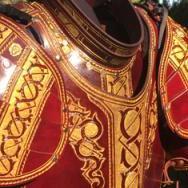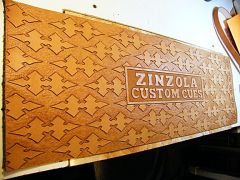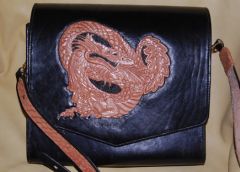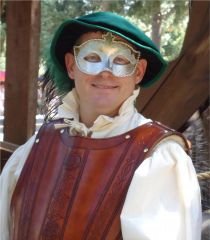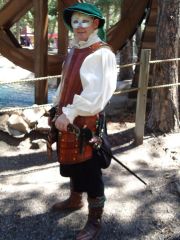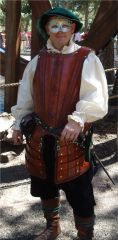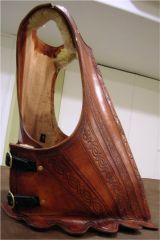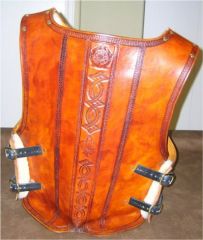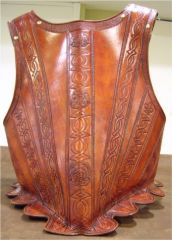-
Posts
85 -
Joined
-
Last visited
Content Type
Profiles
Forums
Events
Blogs
Gallery
Everything posted by Eldorado
-
Will do. Should be able to take the shot and post it in the next couple days.
-
Thanks very much. I like it alot and want to use it on some of my renaissance pieces. I take it you used a light touch with it to make it look pebbled? I realized I've been using the large version of these tools and striking it quite deep to create a border pattern that is very definite. You can see it on my most recent piece at http://leatherworker.net/forum/index.php?showtopic=29726 if you have interest.
-
Thanks. They are 3/8" button studs from Tandy. The button holes go in two different directions because the pull at the top of the base piece is opposite from the direction of pull of the bottom. Doing this forces the gorget into a bit of a conical shape. I've made one of these before using buckles for the base, but this needs to fit under the collar of my previously made peascod armor. A buckle at the shoulder would have torn up the inside of the armor. BTW, I used a sandle buckle from Tandy for the collar. They seem to be closest to an unassuming medieval look that I can find easily. The collar is in two pieces. The outer tooled piece is saddleskirting and is just a simple 1 3/4" strip cut with my strap cutter. The inner piece is 3-4oz vegtan which was cut about 3.5" wide (again with the strap cutter. I ran a swivel knife cut down the inner peice at the 1 3/4" point and then cut slices. It folds under, along the knife cut, and splays out. Where you see the rivets in the collarbone protection piece, they are matching one of the underfolds. I think this is a classic hatband approach, but I just prototyped it for my purposes. I did go ahead and stitch a thin strip of 2oz black deertan to the inside of the inner band before I glued and riveted the outer to the inner. It ends up being sandwiched between the two pieces and extends just a bit past the fold. That was an attempt to present a finished look in the event that there was a gap between the collar and the base. May sound confusing but I can add more if you'd like.
-
-
What do you all think? It has fleece lining over ths shoulders and at the base of the neck. It attaches using two brass button-rivets and a neck strap. It is designed to match the Tudor Rose Peascod armor I made last winter. Which can be found at: http://tudorroseleather.com/armor-wearable/tudor-rose-armor/
-
Thanks very much. I checked The Leather Guy and he seems to be offering prices just above wholesale. He does have bison and deertan cowhide in brown. The price right now for 33 sq ft of bison is only $3.50 or so. That's almost as good as Tandy wholesale for deertan. Have you found their customer service and shipping to be reasonable?
-
Very nice, I'll bet they're soft and comfortable. Where did you get the Bison for that particular pair?
-
Thanks very much. I'll give them a try. I sure do like the feel of Bison, though I'm told we have a Bison shortage at the moment, driving up prices. Any truth to that rumor?
-
Hello all, I'm looking for a soure of deertanned cowhide in different colors. I can easily get black, gold/saddle tan, and natural/off-white from Tandy (and it seems alot of other places), but I'd like to find some other colors. Specifically I'm hunting for some browns (light or dark) and maybe even some other options. I've looked around and see that most places carry the same as Tandy, if they carry any at all. Any suggestions? Thanks in advance, Eldorado www.TudorRoseLeather.com
-
-
I can't see the full armor, just the spaulder and designs for the spaulder. Is that because I'm getting firewall issues or have they been removed? Eldorado
-
Boy, this is great info. Now I have to decide *if* I'm likely to sew the really heavy stuff enough for it to make sense. Getting out of hand sewing the first place is pretty big stuff for me, to begin with. He tells me I should come over to his place and use his machines, then he tells me I shouldnt, because I'd never go back. I really appreciate the depth of your responses. Thanks again. Eldorado
-
Wow, this is a tremendous answer. Thanks. Just to see if I understand correctly, as a maker of historical reenactment stuff, I'm likely to be making sewn pouches out of Deer Tan Cowhide (4-5 oz), satchels (maybe assembled from pieces of 6-7oz), and if possible, sewing pieces of veg tan saddle skirting together. I'd assume this machine would work fine on the pouches, is it reasonable to imagine that it would sew the saddleskirting? or would I be limited to sewing something thinner *to* the saddle skirting? Any help is appreciated. Eldorado
-
Folks, I have a friend/leather-mentor who is a professional leatherworker (saddles, tack, automotive, etc.) who has gotten into buying the assets of leathershops that are going out of business. He then sells the pieces around the country. He tells me he has acquired a Singer 155W (probably made in the 1960's or early 70's) that might be perfect for me, because it is in good shape, but not great, and should keep me sewing very thick leather for years to come. He believes the machine would be better for me as a studied amateur, rather than for a professional shop because it has a couple of minor issues that would cause a "high production shop" more trouble than they need. I hadn't really intended to get a sewing machine at this point, because my plans for taking my leatherworking on the renaissance fair road are a number of years off. I mostly rivet or handsew my stuff now. This machine comes with a mounting table and motor, and it has a walking foot. It also is in an "arm" configuration, which means it can be used to sew something like a quiver tube for arrows. He's a good friend so I'm taking his judgement that the "issues" really arent going to be a problem for me. So the question is, is $300 a decent enough price that I should act sooner rather than later?
-
-
From the album: Ren Faire Stuff
© © leatherworker.net
-
From the album: Ren Faire Stuff
© © leatherworker.net
-
From the album: Ren Faire Stuff
© © leatherworker.net
-
From the album: Ren Faire Stuff
© © leatherworker.net
-
Here are some pics of the armor with the completed tassets and sword belt at Colorado's Ren Fair on Mardi Gras weekend. What do you all think? Eldorado
-
Having created two sets of armor, one out of 10-12oz latigo and one out of saddle skirting I'd have to know more to answer the question. Latigo has no shaping qualities, so you have to shape it by how you cut and assemble it. If you want a curve, you have to cut the line as a curve and rivet or sew it together so it comes together with a curve. You can also place battens in it to force it to shape. However, the second set of armor I made (saddle skirting) required a couple of different techniques for molding. I was going for a "peascod" look on the cuirass, which meant I needed to stretch the leather into a point down around the belly button area. For that section, I used the pointed tip of a staircase bannister to work the shape after getting it really wet. It was also important to place strategic cuts with a swivel knife on the inside to get the cuirass to crease down the center and to pinch in around the kidneys. If you are intending that the armor fit you precisely, then molding around you makes alot of sense. I use strips of soft cloth to tie things on, so they dry but the leather isnt scarred. However, you might want some separation between your body and the armor. For example, a pot belly-sort of approach to a breastplate. Even though you arent fighting in it, the space would be appropriate as a means to absorb some of the impact of a blow. In that case, I say shape it like a sculpture on a table or hanging from a cross piece and keep coming back to it as it dries to adjust it. I'd stay away from a cast form, unless you are working with very thin leather. It is a huge amount of work to get a cast right. I use a cast-marble face form for masks and if I get much over 5oz, I can't get the leather to form to the cast in a meaningful way that is worth the trouble of the cast. All the definition disappears as the leather thickness increases. That said, simple cylinders (like wine bottles) can be nice general shaping forms for arm and leg pieces. Hope this helps Eldorado
-
Vindicated we are. Thanks so much. I'm sure Hivemind will appreciate the direct reference as well. I think we can accept the Met as a proper academic resource. Work continues on the tassets for my leather cuirass. Eldorado
-
Hurray for Milo the Currier! He has validated all my many hours of work. *wink* Certainly would be cool to see what the 38 cuirasses looked like and how they were made. I found reference to the 38 sets of armor provided for the chevaliers at this Tourney (they apparently couldnt bring their own) at The Tournament: Its Periods and Phases By R. Coltman Clephan, Charles Ffoulkes - viewable at this link - http://books.google.com/books?id=5-J-aUiA0XwC&pg=PR11&lpg=PR11&dq=Windsor+Tournament+1278&source=bl&ots=nZMS8zDb2S&sig=_xO55OAyKqT7YZ-17vQE5hsVLlI&hl=en&ei=m1-_S5zqBYXfnAfQ4_D9CQ&sa=X&oi=book_result&ct=result&resnum=5&ved=0CBIQ6AEwBA#v=onepage&q=Windsor%20Tournament%201278&f=false Unfortunately, a further check of the Windsor Tournament of 1278 reveals some interesting contextual information. At this website, http://www.spiritus-temporis.com/tournament-medieval-/jousters.html the Windsor Tourney is characterized as a low-impact attempt at decreasing the intensity of the bloodshed that had begun to take root in the competition circles of the day. Similar, it appears, to adding the "Roughing the Passer" rule to American football. You'll note in this text, as well, that there were rules added to try and control 13th century British Soccer Hooligans. I guess the Brits have always been had this problem. Apparently, the leather was just a part of decreasing the deadliness of the weapons (whalebone) and backing off the protection of the armor to cut down on "unsportsman like conduct." As a result, or to help ensure it, this tourney has come to be known as the Jousts for Peace. While this information actually validates, to a small extent, my original suggestion that lords might wear a lighter, more flexible form of armor to the faire or out-on-the town -- to show perhaps that they are still boss while remaining protected from the knives of cutpurses -- it doesn't in anyway suggest that they used this armor for warfare. Since, that wasnt my original supposition, I'm not bothered by it. But, the argument remains standing (though perhaps with a slight wobble) that the D&D leather armor (studded or not) doesnt reflect reality. I might point out though, that no one said D&D leather armor had to be much more than a leather horseman's jack (essentially the motorcycle leathers of the time). The armor class it imparted (witness my geekyness), wasn't worth much more than that anyway. Eldorado
-
Unfortunately, not I.
-
Wow, quite nice. I recognize some of these from having perused this site. I remember being envious at the time. Thinking about them, I particularly liked the use of the pear shader for the teeth on the mask. It gives it an extra creepy look. Did you use brass hinges on the lorica? or are the chest bits something else? I like adding brass hardware to things, but am frustrated in finding a source. Finally, did the finished arm and leg pieces have the flexibility you wanted? I am concerned that I am overengineering (so far only in my mind) the articulation joints of the arm armor I am planning and wonder if your use of copper rivets gave you the result you wanted. Eldorado



